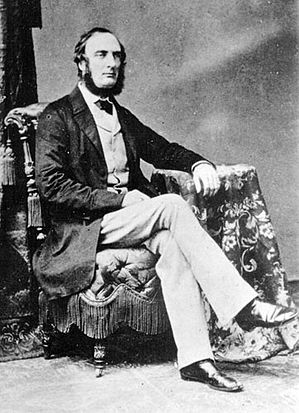John Palliser facts for kids
Quick facts for kids
John Palliser
|
|
|---|---|
 |
|
| Born | 29 January 1817 Dublin, Ireland, United Kingdom
|
| Died | 18 August 1887 (aged 70) Waterford, Ireland, United Kingdom
|
| Occupation | geographer |
John Palliser (born January 29, 1817 – died August 18, 1887) was an Irish geographer and explorer. He is best known for leading a major expedition that explored the land, weather, and nature of what is now western Canada. His work helped people understand this important region.
Contents
Life and Explorations
John Palliser was born in Dublin, Ireland. His father was Colonel Wray Palliser. John served in the Waterford Militia, a type of local army, for many years. He eventually became a captain.
Adventures in North America
John Palliser loved hunting. In 1847, he went on a hunting trip to British North America (which included parts of modern-day Canada). He wrote a book about his adventures called Solitary Rambles and Adventures of a Hunter in the Prairies, which was published in 1853.
The Palliser Expedition
From 1857 to 1861, Palliser led a very important journey called the British North American Exploring Expedition. This team explored the unknown areas of the far west. They mapped the border between British North America and the United States, from Lake Superior all the way to the Pacific Ocean.
Palliser had a skilled team with him:
- Lieutenant Thomas Blakiston, an astronomer who studied stars and maps.
- Eugène Bourgeau, a botanist who studied plants.
- Dr. James Hector, a geologist who studied rocks and the Earth's structure.
During their journey, they explored several rivers, including:
- White Fish River
- Kaministiquia River
- North Saskatchewan River
- South Saskatchewan River
- Red River
In 1859, Palliser received a special award, the Patron's Gold Medal, from the Royal Geographical Society for his detailed survey of the Rocky Mountains. He returned to Ireland in 1862 and shared all his findings with the British Parliament.
Impact of His Work
The information from Palliser's survey was very important. It helped end the Hudson's Bay Company's control over Rupert's Land. Rupert's Land was a huge area that included all the lands drained by rivers flowing into Hudson Bay. This change happened in 1870.
Palliser is remembered for helping to open up the Canadian West for new settlers and development. However, he also warned that a specific area, now known as Palliser's Triangle, was too dry for farming. This region includes parts of what is now southeastern Alberta and southwestern Saskatchewan. Despite his warnings, people tried to farm there. This led to big problems during the Dust Bowl drought, when the land became very dry and dusty.
Later Life
In 1869, John Palliser traveled to Novaya Zemlya in Russia with his brother, Frederick Palliser.
In 1877, he was honored with the title Companion of the Order of St. Michael and St. George (CMG). John Palliser never married. He spent his later years in Ireland, taking care of his family. He passed away at his home in County Waterford, Ireland, in 1887. He is buried in the graveyard of Comeragh Church. The government of Alberta, Canada, has placed a plaque on his grave to remember his great achievements.
Legacy
Many places and things are named after John Palliser to honor his contributions:
- The Fairmont Palliser Hotel in Calgary, Alberta.
- The neighborhood of Palliser in Calgary.
- The Palliser Range of mountains.
- The Palliser Regional School Division.
- The Palliser Formation, a rock layer in the Canadian Rockies.
- The University of Calgary's geography club is called the Palliser Club.
See also
Images for kids


